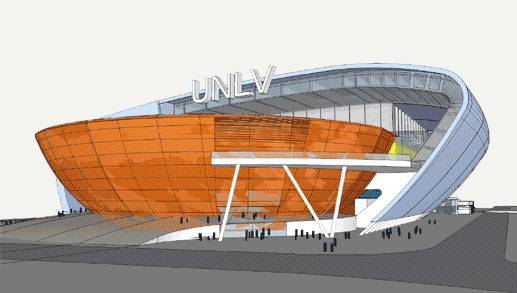
Courtesy UNLV Now
Renderings of a proposed stadium on the UNLV campus.
Thursday, March 1, 2012 | 4:27 p.m.
- Negotiations extended for UNLV stadium project (12-1-2011)
- Developers: A UNLV stadium could be built without raising taxes (9-13-2011)
- Developers continue push for UNLV stadium, retail district (6-28-2011)
- Developers put early plans for UNLV stadium, retail district on display (2-1-2011)
- Regents to hear UNLV arena plan for football, basketball (1-31-2011)
- Mayor: UNLV domed stadium wouldn’t conflict with a downtown Las Vegas arena (1-27-2011)
- Report: UNLV domed stadium plans will be unveiled Tuesday (1-27-2011)
- Goodman: Arena project a key issue for next Las Vegas mayor (1-20-2011)
- UNLV acknowledges effort to bring stadium, football to campus (1-19-2011)
Sun archives
The public-private partners behind a proposed on-campus stadium at UNLV say they will need tax money to build it, after all.
Last September, after the Legislature rejected a special tax district to fund the $2 billion stadium, dormitory and retail project, university officials and Majestic Realty Co. started working on a funding plan they said wouldn't require tax money.
In a project update to the Nevada System of Higher Education's Board of Regents on Thursday, UNLV President Neal Smatresk outlined a new funding plan for construction of a 50,000- to 60,000-seat, closed-top stadium on the west side of the university's Maryland Parkway campus.
The stadium portion of the project is expected to cost $450 million to $500 million, including costs associated with moving displaced facilities from the construction site and practice fields on Harmon Avenue. The project also would require the purchase of some Clark County-owned land west of Swenson Street.
To fund the stadium construction, UNLV would need to raise $35 million per year for the next 20 years, Smatresk added.
"That should take your breath away," Smatresk told regents, adding he remained "ironclad" in his commitment not to use student tuition or general fund dollars to pay for the project.
The project would require four sources of funding, Smatresk said:
• Gifts and pledges from "founding partners" such as corporations, wealthy individuals and municipalities. There have been "a number of prominent entities who have stepped forward to offer support," Smatresk said, adding the “founding parties” would be a significant source of funding.
• Naming rights to the stadium, which may bring in $200 million to $300 million, Smatresk said.
• Future revenues, concessions, ticket sales and advertisements, which would be a smaller portion of the funding equation, Smatresk said.
• Finally, a tax-increment financing district, which would divert tax dollars in a legislatively approved area to be used for economic redevelopment or a special project. The stadium itself would not raise enough tax dollars, but public-private partners are hoping the stadium plus the mixed-use development of retail stores and restaurants would generate necessary funds.
Despite the project's setback last summer to secure the special tax district, university officials and builder-partners are hopeful they can sway public support for the project during the year until the next legislative session.
That calculus comes as the developers released preliminary revenue projections for the new stadium on Thursday.
Currently, the Thomas & Mack Center — with a capacity of 18,000 seats — draws $250 million annually in direct revenue for the state, excluding tax revenue, officials said.
With a UNLV stadium more than double, maybe triple, the size of the Thomas & Mack arena, developers say the stadium could attract larger events, and with them more tourists to the city. UNLV is hopeful the stadium would play host to 15 "major events" each year.
Developers say they conservatively project the stadium's revenue around $500 million annually from lodging, gaming and dining in the region.
"If you want this, you'll need to help us get it," said Craig Cavileer, a stadium developer and president of the Silverton resort. "It can't just be the university and Majestic. It has to be the community."
UNLV and Majestic Realty are expected to present finalized cost projections and funding plan by the June Board of Regents meeting. Construction on the stadium is expected to begin in late 2013.
Developers are still "imagineering" what the university dormitories and retail shops would look like. Renovating the Thomas & Mack Center would come later, Cavileer said.

Join the Discussion:
Check this out for a full explanation of our conversion to the LiveFyre commenting system and instructions on how to sign up for an account.
Full comments policy